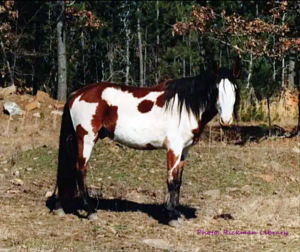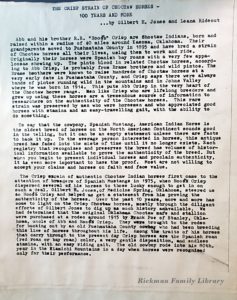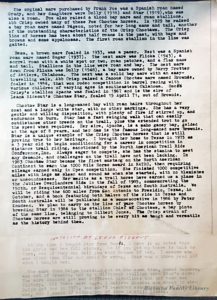
The Crisp Strain of Choctaw Horses
100 Years and More
By Gilbert H. Jones and Leana Rideout
Abb and his brother R.R. “Hoot” Crisp are Choctaw Indians, born and raised within a radius of 40 miles around Kasoma, Oklahoma. Their grandparents moved to Pushmataha County in 1895 and have bred a strain of Choctaw horses all their lives, using them to work and ride.
Originally their horses were Spanish bay roans with a very few appaloosas showing up. The pinto blood in related Choctaw horses, according to Abb Crisp, is probably from Brame brothers and wild pintos. The Brame brothers were known to raise hundreds of Choctaw horses at a very early date in Pushmataha County, and Crisp says there were always bands of pintos running wild in the mountains and in Johns Valley where he was born in 1914.
This puts Abb Crisp in the very heart of the Choctaw horse range. Men like Crisp who are lifelong breeders and grew up using these horses are a tremendous source of information to researchers on the authenticity of the Choctaw horses.
This rare strain was preserved by men who were horsemen and who appreciated good horses with stamina and an easy-traveling gait, with the ability to do something.
To say that the cowpony, Spanish Mustang, American Indian Horse is the oldest breed of horses on the North American Continent sounds good in the telling, but it can be an empty statement unless there are facts to back it up.
To the average person interested in horses, this antique breed has faded into the mists of time until it no longer exists.
Each registry that recognizes and preserves the breed has volumes of historical information available to prove the authenticity of the breed.
But when you begin to present individual horses and proclaim authenticity, it is even more important to have the proof. Most are not willing to accept your claims and horses on faith and face value.
The Crisp strain of authentic Choctaw Indian horses first came to the attention of breeders of Spanish Mustangs in 1975, when Hoot Crisp dispersed several of his horses to those lucky enough to get in on such a deal.
Gilbert H. Jones, of Medicine Springs, Oklahoma, steered us to Hoot Crisp and helped us get a statement from him proving the authenticity of the horses.
Over the past 10 years, more and more has come to light on the Crisp Choctaw horses, mostly through the diligent efforts of Gilbert Jones to dig up as much history as available.
We had determined that the original Oklahoma Choctaw mare and stallion were purchased at a rodeo around 1915 by Frank Poe of Stanley, Oklahoma, uncle of Abb and Hoot Crisp.
They were brought to the rodeo for bucking out by an old Pushmataha County cowboy who had been breeding this line of horses throughout his life. Among the traits of his horses that carry through to the present day Crisp horses are the Spanish roan (red roan or bay roan) color, a very gentle disposition, and endless stamina, with an easy riding gait.
The old cowboy rode into his 80th year in the Kiamichi Mountains in a day when horses were recognized only for their performance.
The original mare purchased by Frank Poe was a Spanish roan named Grady, and her daughters were Dolly (1918) and Star (1919), who was also a roan.
Poe also raised a blood bay mare and roan stallions.
Abb Crisp owned many of these Poe Choctaw horses. In 1929 he raised a bay roan mare named Pigeon, noted for her long mane and tail, another of the outstanding characteristics of the Crisp Choctaws.
The Crisp line of horses has been about half roans in the past, with bays and browns and some appaloosas. The first roan stallion in the line was gaited.
Bess, a brown mare foaled in 1933, was a pacer. Next was a Spanish roan mare named Sugar (1937). The next mare was Flicka (1943), a sorrel roan with a white spot or two, roan patches, and a flax mane and tail. Stallions in the line were roan and bay.
The next mare down from Flicka was Dolly (1948), a bay mare owned by Barry Trotter of Antlers, Oklahoma. The next was a solid bay mare with an easy-traveling walk.
Abb Crisp raised a famous Choctaw mare named Brownie, foaled in 1956, that won rodeo competition in barrel racing with various children of varying ages in southeastern Oklahoma.
Hoot Crisp’s stallion Apache was foaled in 1967 and is the sire of Leana Rideout’s Choctaw Star, foaled 15 April 71, out of Brownie.
Choctaw Star is a long-maned bay with roan hairs throughout her coat and a large white star, with no other markings. She has a very gentle and willing disposition, with plenty of fire if stirred up, and endurance to burn.
Star has a fast swinging walk that can easily outdistance other breeds on the trail, plus the extended trot to go the speed when required.
Her sire, Apache, is a maho ganey bay, gelded at the age of 8 years, and her dam is the famous long-maned mare Brownie.
Star is a unique example of the Crisp Choctaw horses that are still proving true to her heritage.
I brought her home to Texas in 1975 as a 3 year old to begin conditioning for a career in competition in distance trail riding, sanctioned by the North American Trail Ride Conference, Inc.
Always eager to compete, she has the stamina to meet any demands, and challenges on the trail have not been lacking.
In 1983 Choctaw Star became the first Mustang on the North American Continent to earn the 1000 Mile Horse award in NATRC, then requiring mileage earned only in Open Competition. She finished 1000 competitive miles with legs as clean and sound as when she started, with no blemishes or unsoundnesses.
Her merits as a trail horse have earned us a place in the Jubilee Overlanders Ride in the fall of 1985, commenmorating the 150th, or Sesquicentennial birthdays of Texas and South Australia.
We will be riding the 600 miles from San Antonio to Presidio, Texas, in October, and a book featuring both halves of the ride in Texas and South Australia will be published as a commemorative in 1986 by Peter Knudsen.
We plan to carry on the line of pure Choctaw horses by breeding Star in 1986 to the stallion Chief of Choctaws, a bay pinto of the same line, belonging to Gilbert Jones.
The Crisp strain of Choctaw horses are still proving to be every bit as tough and versatile as the history behind them.

A NOTATION by Leana Rideout – A the time I bought Star from Hoot, I have in my notes that his girls had her full sister. So if you get up there to talk to them, see if they can tell you what became of her. I assume she was older than Star but could be wrong. Star was a three year old when I bought her.
The mare that Dolph Morrison got at the same time, named Duchess, was out of Brownie, but by a different stallion than Star’s sire. The mare Stabler got was different bloodlines and her name was Victory.
All three were bays. I believe Duchess was about 12 when Dolph got her in 1975, and can’t remember exactly how old Victory was, but I doubt is either one of them is still living.
The article is a part of the Rickman Family Library and was published in the Summer 1985 Issue of the Southwest Spanish Mustang Association Newsletter.

